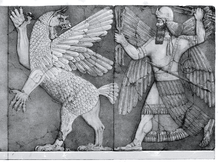Ereshkigal
| Part of a series on |
| Ancient Mesopotamian religion |
|---|
 |
|
Demigods and heroes |
| Related topics |
In Mesopotamian mythology, Ereshkigal (𒀭𒊩𒆠𒃲 DEREŠ.KI.GAL, lit. "Queen of the Great Earth") was the goddess of Irkalla, the land of the dead or underworld. Sometimes her name is given as Irkalla, similar to the way the name Hades was used in Greek mythology for both the underworld and its ruler, and sometimes it is given as Ninkigal, lit. "Great Lady of the Earth" or "Lady of the Great Earth".
Ereshkigal was the only one who could pass judgment and give laws in her kingdom. The main temple dedicated to her was located in Kutha.[1]
The goddess Ishtar refers to Ereshkigal as her older sister in the Sumerian hymn "The Descent of Inanna" (which was also in later Babylonian myth, also called "The Descent of Ishtar"). Inanna/Ishtar's trip and return to the underworld is the most familiar of the myths concerning Ereshkigal.
Source myths
Ereshkigal is the sister and counterpart of Inanna/Ishtar, the symbol of nature during the non-productive season of the year. Ereshkigal was also a queen that many gods and goddesses looked up to in the underworld. She is known chiefly through two myths, believed to symbolize the changing of the seasons, but perhaps also intended to illustrate certain doctrines which date back to the Mesopotamia period. According to the doctrine of two kingdoms, the dominions of the two sisters are sharply differentiated, as one is of this world and one of the world of the dead.
One of these myths is Inanna's descent to the netherworld and her reception by her sister who presides over it; Ereshkigal traps her sister in her kingdom and Inanna is only able to leave it by sacrificing her husband Dumuzi in exchange for herself.
The other myth is the story of Nergal, the plague god. Once, the gods held a banquet that Ereshkigal, as queen of the Netherworld, could not come up to attend. They invited her to send a messenger, and she sent her vizier Namtar in her place. He was treated well by all, but for the exception of being disrespected by Nergal. As a result of this, Nergal was banished to the kingdom controlled by the goddess. Versions vary at this point, but all of them result in him becoming her husband.[2] In later tradition, Nergal is said to have been the victor, taking her as wife and ruling the land himself.
It is theorized that the story of Inanna's descent is told to illustrate the possibility of an escape from the netherworld, while the Nergal myth is intended to reconcile the existence of two rulers of the netherworld: a goddess and a god. The addition of Nergal represents the harmonizing tendency to unite Ereshkigal as the queen of the netherworld with the god who, as god of war and of pestilence, brings death to the living and thus becomes the one who presides over the dead.
Other details
In some versions of the myths, she rules the underworld by herself, sometimes with a husband subordinate to her named Gugalana. It was said that she had been stolen away by Kur and taken to the underworld, where she was made queen unwillingly.[3]
She is the mother of the goddess Nungal. Her son with Enlil was the god Namtar. With Gugalana her son was Ninazu.
See also
Notes and references
- ↑ "Ereshkigal", Encyclopædia Britannica Ultimate Reference Suite DVD, 2003.
- ↑ "Nergal and Ereshkigal" in Myths from Mesopotamia, trans. S. Dalley (ISBN 0-199-53836-0)
- ↑ Sumerian Mythology
Sources
- Gods, Demons and Symbols of Ancient Mesopotamia by Jeremy Black and Anthony Green (ISBN 0-292-70794-0)
- The Gilgamesh Epic and Old Testament Parallels by Alexander Heidel (ISBN 0-226-32398-6)
- Inanna: Queen of Heaven and Earth" by Diane Wolkenstein and Samuel Noah Kramer (ISBN 0-06-090854-8)
-
 This article incorporates text from a publication now in the public domain: Chisholm, Hugh, ed. (1911). "article name needed". Encyclopædia Britannica (11th ed.). Cambridge University Press.
This article incorporates text from a publication now in the public domain: Chisholm, Hugh, ed. (1911). "article name needed". Encyclopædia Britannica (11th ed.). Cambridge University Press.
External links
- Ancient Mesopotamian Gods and Goddesses: Ereškigal (goddess)
- "Inana's descent to the nether world" - from The Electronic Text Corpus of Sumerian Literature by the Oriental Institute of the University of Oxford

